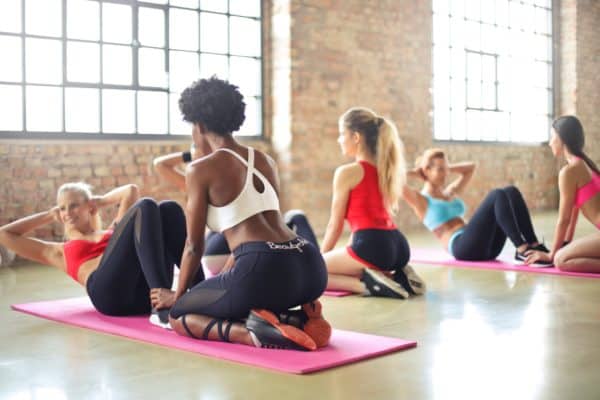
Finding the motivation to get yourself to the gym or to begin an at-home workout is not easy. Even though we’re surrounded and continuously bombarded by a culture of looking fit and skinny, saying you’ll work out and doing it are two very different things. Most of winning the battle to get fit is merely showing up, whether at the gym or a boutique fitness studio. So how do we find the motivation to get on our workout clothes and get out the door? Below are a few essential tips that have been proven to help find the motivation to get your workout on.
Find an Accountability Partner
The best way to stay motivated to workout is to find someone that you can either exercise with or talk with on a regular basis to share schedules, discuss challenges and victories, and learn something new in health and fitness. Chris Gregory personal trainer at UP London says that “Accountability is one of the most underrated aspects of fat loss. Having someone you hold yourself accountable to is critical to success – and not only in the gym. Another advantage of a good training partner is you’ll be able to take sets further than you expected, sneak in a few more reps, and most importantly, be able to push yourself to the limit safely.” This is why coaches and personal trainers are so effective. While it’s easy for us to let down ourselves and not show up to the gym, we naturally do not want to let down others. For those who cannot afford a personal trainer, you can recruit a friend, sign up for a group chat or Facebook group, or organize one yourself. It’s free and surprising at how much this will improve your motivation.
Set Small and Large Goals

It’s important to have fitness goals if you’re looking to get into the gym or to a studio on a more regular basis. Setting small goals will help in the short term, while large goals alone can feel unattainable and too far away. If you don’t set any goals for yourself, it’s easy to find reasons not to get to the gym. An example of small goals can include things like going to the gym a certain number of times in a month, trying out that new boutique studio you’ve wanted to check out, or eating one healthy meal per day for a month. Larger goals usually consist of a certain weight or body fat percentage or could be goals like running a marathon or squatting your bodyweight. Setting larger goals that are performance-based are more likely to be hit than body weight goals since body weight goals are more superficial. Try to find a significant, performance-based goal you are passionate about and work towards that, setting small and achievable goals along the way for continued motivation.
Remind Yourself of Your Goals
It’s one thing to set small and large goals, but the next step is reminding yourself of your goals. When you’re thinking about skipping a workout, ask yourself if this decision will help or hinder your goals. It has been shown that spending a few moments reflecting on this potential choice will ultimately lead to making the decision that will more positively affect your ultimate goals. Reminders can also be actions such as weighing yourself regularly, leaving notes or images around your home or office or starting a daily journal.
Setup a Rewards System
You’ll need a reward system as well for when you begin achieving your small goals and giving yourself something to look forward to. Try to stay away from rewards that will hinder your larger goal, such as unhealthy foods or breaks from exercise. Instead, focus on rewards that will reinforce your larger goals. This could include things like buying a new fancy gym bag or gym outfit, signing up for a personal training package, massage or even a trip to the beach to show off your new body. Being able to look at the calendar and see future rewards (if you complete your small goal) will help to find the motivation to get to the gym.
Track Your Progress
To make sure you are tracking towards your small and large goals, it’s essential to track your progress. There are many ways to track progress, so it’s important to experiment and find what works best for you. Examples include weighing yourself regularly, writing in a daily journal or tracking food through an app like MyFitnessPal. The best method of tracking would involve the added component of being able to write about how you’re feeling and any potential challenges throughout the day, so you can better learn what types of foods and workouts lead to the best results for you.
Dress the Part
Another strong motivator for working out is to buy clothes and gear that you’re excited to workout in. You should make sure the clothing is comfortable, but also has performance features, like breathability or wicking, to make sure you are comfortable during and after your workout as well. Some types of clothing to look for are cotton/polyester blends, wool if you are not allergic, or any awesome compression clothes which can help to prevent muscle soreness and improve circulation. If you are excited about the clothes you plan to wear to the gym or your next fitness class, you’ll be more likely to want to put them on and then head out the door. Add any workout clothes you want to buy to your next reward for meeting another small goal, and soon you’ll be crushing your workouts and dressed the part.
There’s an App for That
This can be related to previous motivators such as tracking and finding accountability partners depending on which app you use. Some fitness apps contain tracking tools, some have coaches you can access with monthly fees, some have workouts you can do both in the gym or at home, and some provide access to a community for support and motivation. You’ll want to determine the reasons for why you need an app for support before researching which to download. If there are monthly fees associated with the one you want, it might be worth it to try and see how you like it. If a small monthly fee is a difference between failing and hitting your goals, it could be seen as a smart investment.
Publicize Your Goals

Not always the easiest to act on for those who have experienced failures in the past, but making public your goals can lead to increased external motivation and the desire not to disappoint those around you helping you succeed. While it may seem terrifying at first to think about going public with your goals, it will feel like a weight lifted off your chest and a reduced burden to manage your new daily routine on your own. Instead, you’ll have loved ones checking in, friends joining you on your journey and even strangers rooting for you on social media, all helping to fuel the internal fire to stay motivated and progress towards your small and large goals.
Switch It Up
To prevent any boredom in achieving your fitness goals, make sure you identify any potential areas or points in the journey where you’ll want to switch up your routine. If you like routine and thrive in that environment, you may not need this support. However, for those thinking they’ll face boredom during their fitness journey, make sure to put some plans in place. This could include trying out a new location of the gym you go to, changing up the time of day that you work out, or going to a new boutique fitness studio to try out a new type of class.
 Gearfuse Technology, Science, Culture & More
Gearfuse Technology, Science, Culture & More


